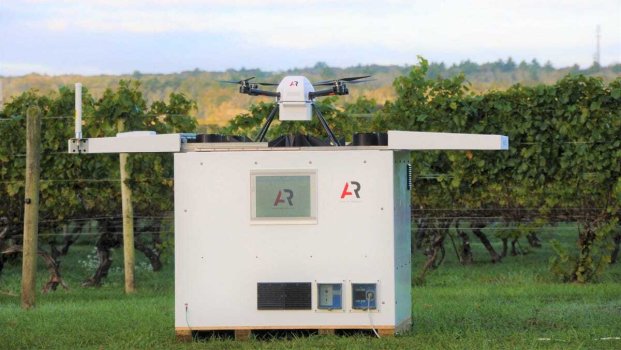K
Kathleen Martin
Guest
The commercial drone industry is expected to grow at a compound annual growth rate of 57% from 2021 to 2028 as a result of the need for better data and analytics that only drones provide. In order for drones to reach their full potential, drone developers must work with the Federal Aviation Administration (FAA) to manufacture devices that can safely and successfully operate under Aviation Rulemaking Committee (ARC) and FAA guidelines.
That's the clarion call of American Robotics, the first company approved by the FAA to operate automated drones without humans on-site, which was recently selected to participate on the FAA's Unmanned Aircraft Systems (UAS) Beyond-Visual-Line-of-Sight (BVLOS) Aviation Rulemaking Committee (ARC) to advance BLOVS drone operations. In the eyes of co-founder and CEO Reese Mozer, the FAA's approach to BLOVS flight for commercial drones will dictate the state of the drone industry for years to come, and it's up to the industry to do all it can to work in lockstep with the regulator.
I sat down with Mozer about why the drone sector needs to work with the FAA and what that means for the future of drone delivery and other BVLOS applications.
GN: What's the FAA's current policy on BVLOS, and what are the FAA's primary concerns when it comes to BVLOS?
Reese Mozer: The FAA's mission and responsibility is the safety of the National Airspace System (NAS), including people and property in both the skies and on the ground. Prior to American Robotics 2021 waiver and exemption, no company had demonstrated to the FAA safe operation without human visual observers (VOs) on-site. The reasons for this are numerous and complex and are both technological and cultural. The short explanation is that humans have been a constant presence during flight for the past hundred years, and ultimately, the primary failsafe if anything goes wrong. Shifting more of this responsibility to software and hardware required a series of technology innovations to be developed, tested, and adequately communicated to regulators at the FAA.
For the past five years, American Robotics has been developing a suite of proprietary technologies explicitly designed to produce the industry-leading solution for safe automated flight. We designed these technologies in concert with a low-risk Concept of Operations (CONOPS) and conducted extensive testing and evaluation as part of a long-term regulatory strategy to prove our system's safety.
For example, the Scout System incorporates multiple novel risk mitigations, including proprietary detect-and-avoid (DAA) sensors and algorithms, advanced automated system diagnostics and failsafes, automated pre-flight checks, and automated flight path management. If anything were to deviate from the expected, safe operation plan, our drone systems take immediate action to correct, such as altering flight course and returning to the base station. By developing a layered, redundant system of safety that includes these proprietary technical and operational risk mitigations, we have proven that its drone-based aerial intelligence platform operates safely in the NAS, even when it conducts flights beyond-visual-line-of-sight (BVLOS) of both the operator as well as any humans on-site.
Continue reading: https://www.zdnet.com/article/hey-drone-industry-time-to-work-with-the-faa/
That's the clarion call of American Robotics, the first company approved by the FAA to operate automated drones without humans on-site, which was recently selected to participate on the FAA's Unmanned Aircraft Systems (UAS) Beyond-Visual-Line-of-Sight (BVLOS) Aviation Rulemaking Committee (ARC) to advance BLOVS drone operations. In the eyes of co-founder and CEO Reese Mozer, the FAA's approach to BLOVS flight for commercial drones will dictate the state of the drone industry for years to come, and it's up to the industry to do all it can to work in lockstep with the regulator.
I sat down with Mozer about why the drone sector needs to work with the FAA and what that means for the future of drone delivery and other BVLOS applications.
GN: What's the FAA's current policy on BVLOS, and what are the FAA's primary concerns when it comes to BVLOS?
Reese Mozer: The FAA's mission and responsibility is the safety of the National Airspace System (NAS), including people and property in both the skies and on the ground. Prior to American Robotics 2021 waiver and exemption, no company had demonstrated to the FAA safe operation without human visual observers (VOs) on-site. The reasons for this are numerous and complex and are both technological and cultural. The short explanation is that humans have been a constant presence during flight for the past hundred years, and ultimately, the primary failsafe if anything goes wrong. Shifting more of this responsibility to software and hardware required a series of technology innovations to be developed, tested, and adequately communicated to regulators at the FAA.
For the past five years, American Robotics has been developing a suite of proprietary technologies explicitly designed to produce the industry-leading solution for safe automated flight. We designed these technologies in concert with a low-risk Concept of Operations (CONOPS) and conducted extensive testing and evaluation as part of a long-term regulatory strategy to prove our system's safety.
For example, the Scout System incorporates multiple novel risk mitigations, including proprietary detect-and-avoid (DAA) sensors and algorithms, advanced automated system diagnostics and failsafes, automated pre-flight checks, and automated flight path management. If anything were to deviate from the expected, safe operation plan, our drone systems take immediate action to correct, such as altering flight course and returning to the base station. By developing a layered, redundant system of safety that includes these proprietary technical and operational risk mitigations, we have proven that its drone-based aerial intelligence platform operates safely in the NAS, even when it conducts flights beyond-visual-line-of-sight (BVLOS) of both the operator as well as any humans on-site.
Continue reading: https://www.zdnet.com/article/hey-drone-industry-time-to-work-with-the-faa/

